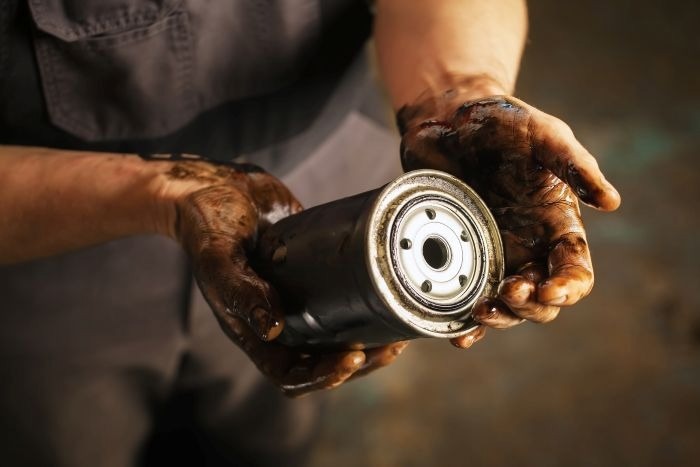Vacuum casting is used in the manufacture of important mechanical parts, such as engine components, turbine blades, shafts and gears. This technology combines several advantages, including improved efficiency, reduced defects and minimal material waste, making manufacturing more reliable and sustainable.
 Reality of handling an oil-flooded vacuum pump. Image Credit: Leybold GmbH
Reality of handling an oil-flooded vacuum pump. Image Credit: Leybold GmbH
In today's manufacturing world, sustainability is increasingly important. Companies are no longer focused solely on efficiency and profit, but on reducing waste and environmental impact as well. Vacuum-assisted casting allows for responsible use of resources and proper equipment maintenance, leading to improved performance and lower energy consumption. This process is an essential component in modern vehicle production for automobiles, aircraft and trains.
High-Precision and Extremely Durable Parts
Vacuum plays a crucial role in casting, preventing air entrapment, reducing oxidation, improving mold filling, enhancing surface quality, controlling metal solidification and enabling the production of thin-walled light-weighting castings parts. By creating a controlled, low-pressure environment, vacuum-assisted casting reduces the risk of porosity. It also improves mold filling and increases the surface quality of the castings. This process is particularly advantageous for producing high-precision and extremely durable parts, making it an important technology in the modern production of castings and components.
Oil-Lubricated Vacuum Pumps
Various types of vacuum pumps with various operating principles can be used in casting plants. In the past, these included oil-lubricated blocking vane pumps or oil-lubricated rotary vane pumps, which were often combined with Roots pumps for increasing pumping speed in lower pressure ranges. Oil-filled vacuum pumps have generally earned a good reputation and have proven their reliability over many years. Oil, which serves as the working fluid in vacuum pumps, acts as a coolant, lubricant and sealant. However, it also presents the disadvantage of absorbing contaminants, such as metal dust, particles and process by-products that arise during the casting process. Regularly changing the vacuum oil in these pumps is essential for maintaining their performance and ensuring high-quality castings.
Dry-Compressing Vacuum System
Modern dry-compressing vacuum pumps do not cause the same problems due to their oil-free compression mechanism. The most modern pumping principle is that of a screw pump with a fast-rotating screw rotor pair. Using this type of pump in a casting machine significantly reduces the maintenance and operating costs of the vacuum system. Comparing the annual operating costs of an oil-lubricated system with those of a dry-compressing vacuum system of similar performance results in significant cost savings.
Power Consumption:
At most operating points, modern dry screw pumps consume less energy than oil-lubricated pumps due to the oil viscosity alone. Modern dry-compressing vacuum pumps have fast-rotating screw rotors which rotate frictionlessly in the compression chamber, resulting in low energy consumption. For most of their operating time, the vacuum pumps even operate at pressures of <10 mbar, where power reduction is greatest.
Service and Maintenance Requirements:
Casting is not a clean application. Vacuum pumps take in significant amounts of dust. Even with the use of a dust filter, oil-lubricated pumps wear out, as no filter can capture the very finest dust particles which then clump together in the pump oil to form a sort of "grinding paste". In dry pumps, however, such small particles are simply transported to the exhaust, causing no wear. Integrating dry pumps into a casting system (ideally with the appropriate filtration for capturing potentially large particles) significantly reduces maintenance and operating costs associated with vacuum systems. Comparing the annual costs of an oil-lubricated system with those of a dry-running vacuum system of the same capacity, casting plant operators achieve significant cost savings.
Smart Features
The benefits of dry vacuum systems go beyond lower power consumption and maintenance requirements (including reduced labor and resource requirements, such as oil, spare seals and blades). Modern dry-compressing pumps offer features or accessories for optimizing energy consumption, such as energy savers, frequency-controlled operation and intelligent controls which maximize pump efficiency when needed. During the initial pumping of the mold from atmospheric pressure to 1 mbar, a dry solution typically operates at full power. However, during subsequent steps, such as cooling, heating, preheating or idling, dry vacuum pumps can reduce their speeds to required base levels in order to save even more energy. When the main PLC sends the restart signal to the frequency converter or the vacuum system control cabinet, the pump returns to full speed within seconds. Leybold’s product portfolio includes a range of dry-compressing and oil-sealed pumps tailored to the foundry industry.
Efficiency and Sustainability
Vacuum-assisted casting plays an important role in the world of industrial machinery. To meet global requirements of resource optimization and waste management, minimizing CO2 emissions, optimizing energy consumption and improving equipment reliability and safety are all critical. The use of dry-compression vacuum systems goes a step further in achieving these goals and offers improved efficiency and sustainability.
Vacuum-assisted casting is strategically important in modern manufacturing, particularly in the automotive, aerospace and rail industries. It increases efficiency, reduces defects and minimizes material waste, making production more sustainable. Vacuum technology improves mold filling, reduces porosity and enhances surface quality by creating a controlled, low-pressure environment.
Conventional oil-lubricated vacuum pumps have proven their worth in the past, but require frequent maintenance due to oil contamination. Modern dry-compression vacuum pumps, on the other hand, eliminate this problem and reduce operating costs and energy consumption. By reducing power consumption, maintenance requirements and resource dependency, dry-compression vacuum systems also contribute significantly to greater efficiency and sustainability of the casting process.